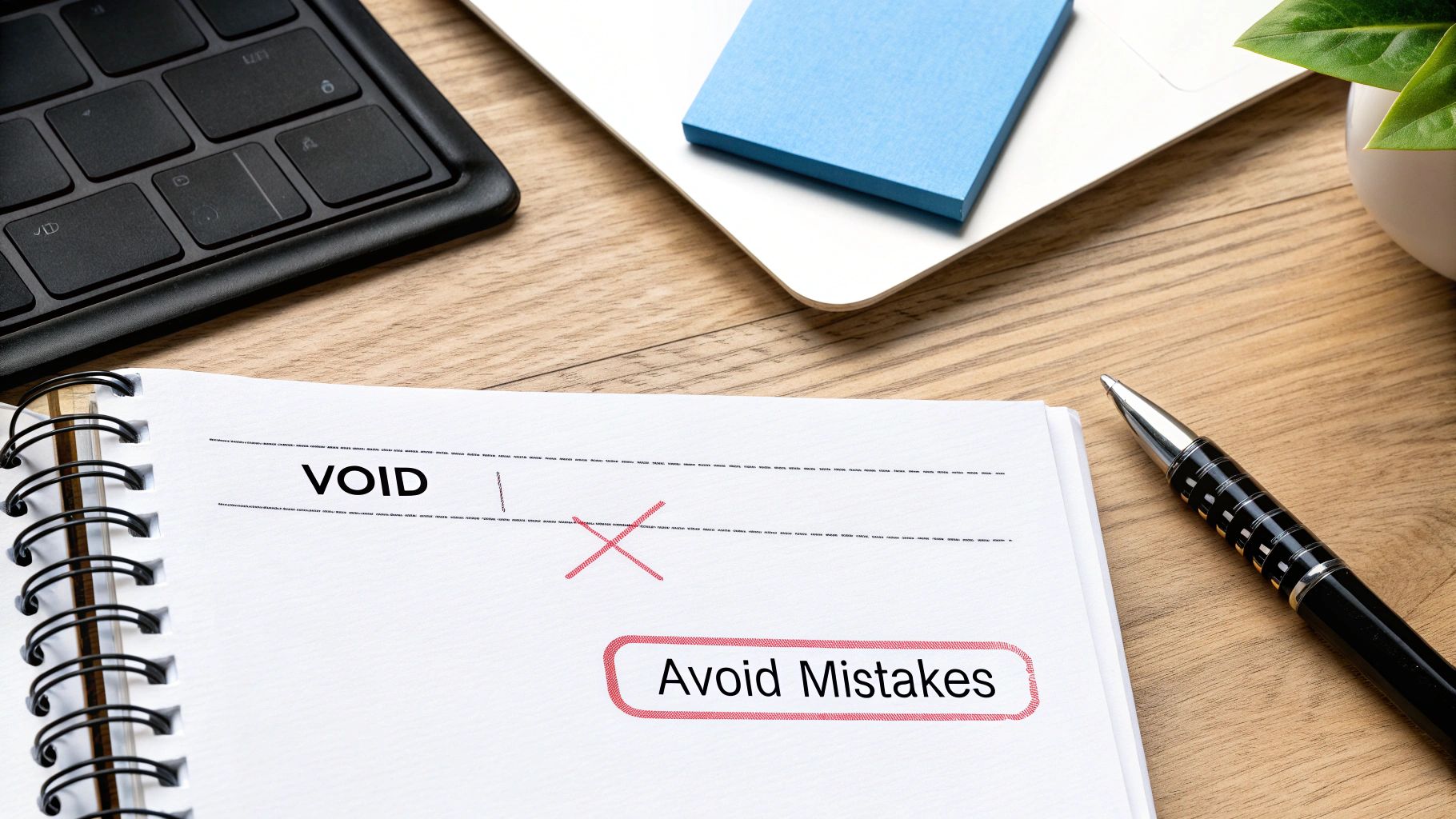At its heart, the profit and loss formula is a straightforward calculation: you take your total revenue and subtract your total expenses. The number you’re left with shows your business’s net profit or loss for a specific period. It’s the core of an income statement and gives you a clean, honest snapshot of your financial performance. We know it can be tough to face the numbers, but this is the first step toward real financial control.
Why the Profit Loss Formula Matters
The profit and loss statement, driven by this simple formula, is a cornerstone of financial reporting for companies all over the world. Here in the United States, public companies are required to file these statements quarterly and annually. Investors and analysts pore over them to gauge a company’s financial health. You can explore more about these financial reporting standards to see just how critical this formula is.
But this isn’t just a stuffy requirement for giant corporations. It’s a fundamental tool for any business owner or trader, no matter the size.
Your Business’s Financial Pulse
Mastering this formula is the first real step toward taking control of your financial destiny. Without it, you’re basically flying blind, making big decisions based on gut feelings instead of hard data. It’s a common struggle, but a solid grip on your profit and loss is what helps you move from hopeful guesses to confident, data-driven strategy.
Think of the profit loss formula as a regular health check-up for your business or trading account. It tells you exactly where you stand, highlighting strengths to build on and weaknesses that need attention before they become serious problems.
Moving Beyond Simple Math
The true power here isn’t just in the final number. It’s in the story that number tells about your day-to-day operations. It uncovers insights that can shape your strategy and build a stable, long-term future. This isn’t about finding a secret to instant success; it’s about building the discipline for sustained growth.
By regularly calculating your profit and loss, you can start to:
- Identify Trends: Are you becoming more profitable, less profitable, or just treading water? Seeing a small dip in profits for three months straight is a crucial early warning.
- Assess Efficiency: Pinpoint if your expenses are creeping up too high compared to the money you’re bringing in.
- Inform Pricing Strategies: Figure out if your products or services are priced right to actually make money.
- Guide Budgeting: Make smarter calls on where to invest your resources for future growth.
This kind of discipline is what separates businesses that thrive from those that just struggle along. It’s about building a habit of financial awareness that pays off for years to come.
The Core Components of the Formula
To really get a handle on profit and loss, you have to know its building blocks. Think of it like a recipe — each part has a specific role, and when you put them all together, you get the full picture of your financial performance. Let’s break down the key terms you’ll run into without the confusing jargon.
At its heart, the formula is simple: Revenue – Expenses = Net Profit (or Loss). But “Expenses” is a pretty big bucket, so we need to get more specific for this information to be truly useful.
Unpacking Your Revenue and Direct Costs
First up is Revenue, sometimes called Sales or Income. This is the total amount of money you bring in from selling your products or services. It’s your top-line number before a single cost is taken out.
Next, you have the Cost of Goods Sold (COGS). These are the direct costs tied to creating what you sell. If you run an online store, this would be what you paid for your inventory, raw materials, and even the packaging. Subtracting COGS from Revenue gives you your Gross Profit.
Gross Profit = Revenue – Cost of Goods Sold (COGS)
This initial calculation is a fantastic indicator of your core business efficiency. It tells you exactly how much money you’re making from your products before accounting for any overhead.
Accounting for Operating Expenses
Gross Profit is a great start, but it doesn’t tell the whole story. To run your business, you have Operating Expenses (OpEx). These are all the indirect costs needed to keep the lights on, whether you sell one item or a thousand.
Examples of operating expenses include things like:
- Marketing and advertising costs to get customers in the door
- Salaries and wages for your team
- Rent or mortgage payments for your office or warehouse
- Software subscriptions and utility bills
Subtracting these from your Gross Profit reveals your Operating Profit, which shows how profitable your day-to-day business operations are.
To help you get comfortable with these terms, here’s a quick-reference table.
Key Terms in the Profit and Loss Formula
| Term | Simple Definition | Practical Example |
|---|---|---|
| Revenue | All the money you earn from sales before any costs. | A coffee shop makes $10,000 in one month from selling coffee. |
| COGS | Direct costs to produce your goods or services. | The coffee shop spent $2,500 on coffee beans, milk, and cups. |
| Gross Profit | What’s left after subtracting COGS from Revenue. | $10,000 (Revenue) – $2,500 (COGS) = $7,500 Gross Profit. |
| Operating Expenses | Indirect costs to run the business. | The shop paid $3,000 for rent, salaries, and marketing. |
| Net Profit | The final “bottom line” profit after all expenses. | $7,500 (Gross Profit) – $3,000 (OpEx) = $4,500 Net Profit. |
Once you’ve figured out your profitability, the next logical step is to measure those gains against your initial capital. You can learn more by checking out our guide on how to calculate return on investment.
After all operating costs, interest, and taxes are paid, you’re left with the bottom line: Net Profit. This is the ultimate measure of profitability and the number that shows what your business truly earned — or lost — over a specific period. Getting these components down is the first step toward disciplined, long-term financial management.
Calculating Profit and Loss Step by Step
Knowing the formula is one thing, but actually putting it to work is where the magic happens. Let’s walk through a practical, real-world example to see how it all comes together. We’ll use a small online store that sells custom-printed t-shirts to turn these abstract concepts into solid, workable numbers.
This process really helps you see how your total income gets whittled down by costs until you’re left with your actual profit.

Think of it this way: every dollar that comes in has to first pay for the product itself, then the costs of running the business. What’s left at the end is what you’ve truly earned.
A T-Shirt Store’s Monthly Finances
Let’s imagine your online t-shirt shop had a good month, bringing in $10,000 in total sales. This is your Revenue — the starting line for our calculation.
First, we need to subtract the direct costs of creating and selling those shirts.
-
Calculate Gross Profit: This means adding up your Cost of Goods Sold (COGS).
- Cost of blank t-shirts: $2,000
- Printing and supplies: $1,000
- Shipping materials: $500
- Total COGS = $3,500
Now, find your Gross Profit by subtracting COGS from your Revenue:
$10,000 (Revenue) - $3,500 (COGS) = $6,500 (Gross Profit)
That $6,500 is the profit you made from selling your products, before accounting for any of the day-to-day business expenses.
Factoring in Operating Expenses
A $6,500 Gross Profit is a healthy start, but it’s not what you get to take home. Next up, we have to subtract the Operating Expenses (OpEx) — all the costs required to keep the lights on.
- Website hosting and software: $150
- Marketing and social media ads: $1,000
- Payment processing fees: $300
- Total Operating Expenses = $1,450
With these costs tallied, we can finally calculate the Net Profit, which is your true bottom line.
Net Profit = Gross Profit – Operating Expenses
$6,500 (Gross Profit) - $1,450 (OpEx) = $5,050 (Net Profit)
After every single bill is paid, your t-shirt store’s final profit for the month is $5,050. This disciplined, step-by-step approach is crucial for understanding your business’s financial health. It turns a jumble of numbers into a clear story.
If you want to make this process even easier, a pre-built spreadsheet can be a game-changer. You can get started quickly and keep your numbers straight by using our detailed profit and loss template for Google Sheets.
Using the Formula to Make Smart Decisions
Your profit and loss statement is so much more than a historical record of what happened — it’s a powerful roadmap for your future. The real value of the profit loss formula comes alive when you use it to make strategic moves, turning those raw numbers into actionable intelligence.
This is all about reading between the lines to uncover the story your finances are telling. It helps you move past gut feelings and start making decisions based on solid evidence, which is a difficult but essential discipline for long-term success.
Spotting Trends and Opportunities
Imagine you run a small e-commerce business. By consistently calculating your profit and loss, you notice that your marketing expenses have shot up by 30% over the last quarter, but your revenue has only nudged up by 5%.
This insight is a flashing red light. It tells you that your current marketing strategy isn’t delivering the return you expected. Instead of blindly pouring more money into the same campaigns, you can now make an informed decision to:
- Analyze your ad spend: Pinpoint which channels are underperforming and reallocate your budget to what’s actually working.
- Test new creative approaches: Experiment with different messaging or visuals to see what truly resonates with your audience.
- Focus on customer retention: Shift some resources toward email marketing to encourage repeat purchases from existing customers, which is often far more cost-effective.
Making Strategic Cost Adjustments
Let’s look at another practical scenario. You see that your Cost of Goods Sold (COGS) is slowly creeping up, eating into your gross profit margin. This is a common struggle that keeps many business owners up at night.
Armed with this data, you can start investigating your supply chain. You might discover an opportunity to source materials from a different supplier at a lower cost without sacrificing quality, which would directly boost your bottom line on every single sale.
This proactive approach transforms your financial statement from a passive report into a dynamic tool for growth. For traders, this same principle of detailed analysis is vital. In fact, consistently tracking your performance is a key step in effectively calculating trading profit and refining your strategies over time. It’s all about building the discipline to look at the numbers, understand what they mean, and act on them decisively.
Common Mistakes to Avoid in Your Calculations

Even with a solid grasp of the profit loss formula, it’s shockingly easy for small errors to creep in and give you a warped view of your finances. We’ve all been there, juggling a million details at once. The first step to building accurate, long-term financial discipline is knowing where the common traps are.
One of the biggest culprits? Forgetting those small, out-of-pocket cash expenses. That morning coffee you bought for a client or the quick trip for printer paper might seem trivial, but trust me, they add up. When you ignore them, you’re artificially inflating your profit on paper, which can lead to a dangerously misleading picture of your business’s health.
Another classic mistake is mixing personal and business finances. Swiping the business card for groceries or covering a business expense with your personal account blurs the lines, making an accurate profit calculation almost impossible. This habit is a bookkeeper’s nightmare and can cause major headaches come tax season.
Adopting Sound Accounting Practices
To get reliable numbers, you need to pick an accounting method and stick with it. The two main players are cash and accrual accounting.
The cash method is straightforward: you record income when the money hits your account and expenses when you actually pay them. Simple.
The accrual method, on the other hand, records income when it’s earned and expenses when they’re incurred, regardless of when cash changes hands. This approach gives you a much more accurate view of your profitability over time. In fact, a 2022 survey found that while 87% of large corporations use the accrual method, only 42% of small businesses do, often because it seems more complex. If you’re curious to see how this works in the real world, check out these profit and loss statement examples.
Financial discipline isn’t about getting it perfect from day one; it’s about building consistent habits. Start small: open a separate bank account for your business and track every single expense, no matter how minor.
Ultimately, the goal is to build a system you can count on. By sidestepping these common errors, you ensure your P&L statements are a true reflection of your hard work, giving you the confidence to make smart, strategic decisions.
Got Questions? We’ve Got Answers
You’ve got the basics down, which is awesome. But as with anything in finance, the devil is in the details. Let’s tackle a few common questions that pop up once people start putting the profit loss formula to work.
Getting these concepts straight is what separates a casual bookkeeper from someone who truly understands the financial pulse of their business.
P&L Statement vs. Balance Sheet: What’s the Difference?
Think of it like this: a Profit and Loss (P&L) statement is like a movie of your business’s financial story over a specific time, like a month or a quarter. It shows the action — your sales coming in and expenses going out — to reveal whether you ended with a profit or a loss.
A Balance Sheet, on the other hand, is a single snapshot in time. It’s a photograph of what your company owns (assets) and what it owes (liabilities) on a particular day. Both are critical, but they tell you very different things about your business’s health.
How Often Should I Be Calculating Profit and Loss?
For most small businesses and active traders, doing this monthly is the sweet spot. I know, it sounds like another task on an already full plate, but this discipline is your early-warning system. It helps you catch problems before they snowball and spot positive trends you can double down on.
At the absolute minimum, you should run the numbers quarterly for big-picture planning and annually for tax time. The key is consistency. Make it a habit, and you’ll always have control over your financial direction.
Isn’t Profit Just the Same as Cash Flow?
Nope, and this is a big one. It’s probably the most common (and dangerous) mix-up for new business owners. We’ve seen this trip up even the smartest entrepreneurs.
Profit is what’s left after you subtract all your expenses from your revenue. It’s a measure of profitability on paper. Cash flow, however, is the actual cash moving in and out of your bank account.
You can be wildly profitable but have zero cash in the bank if your clients haven’t paid their invoices yet. You need to track both to get a true picture of your financial health.
Can I Use This for My Personal Finances?
Absolutely! It’s one of the most powerful things you can do for your personal budget. Your salary is your “revenue,” and everything else — rent, groceries, gas, subscriptions — are your “expenses.”
Subtract your expenses from your income each month. Did you end with a surplus (profit) or a deficit (loss)? This simple, practical calculation is the first step to taking control of your money and hitting your personal financial goals.
Ready to bring this same level of clear-eyed analysis to your trading performance? TradeReview gives you the tools to journal every trade, dissect your strategy with powerful analytics, and turn raw data into smarter, more confident decisions.
Start your free trading journal today and see what a difference clarity can make.


